Complete Solutions to Problems for practice of chapter LAWS OF MOTION of Class 11 book with complete answers and questions
| Class 11 | PHYSICS |
| Chapter | LAWS OF MOTION |
| PRADEEP | Problems for practice |
| Number Of Questions | 100 |
| Academic Year | 2023-24 |
A `20` gram bullet moving at `300m//s` stops after penetrating `3cm` of bone. Calculate the average force exerted by the bullet .
02:49View SolutionA ship of mass `3xx10^7kg` initially at rest, is pulled by a force of `5xx10^5N` through a distance of 3m. Assuming that the resistance due to water is negligible, the speed of the ship is
02:28View SolutionA force produces an acceleration `16m^(-2)` in a mass `0.5 kg` and an acceleration `4ms^(-2)` in an unknown mass when appied separately If both the masses are tied together what will be the acceleration under same force ? .
02:07View SolutionA stone of mass `5kg` falls from the top of a cliff `50m` high and buries `1m` deep in sand . Find the average resistance offered by the sand and the time it takes to penetrate .
08:48View SolutionA man in a circus show jumps from a height of `10m` and is caught by a net spred below him The net sags down `2m` due to impact Calculate average force exerted by the net on the man stop his fall Take mass of man = 60 kg and acc. During free fall`=10 m//s^(2)` .
03:00View SolutionA block of metal weighing `4kg` is resting on a frictionless plane . It is struck by a jet of releasing water at the rate of `1 kg s^(-1)` and at a speed of `10ms^(-1)` Calculate the intial acceleration of the blocks .
04:49View SolutionA force of `50N` is inclined to the vertical at an angle of `30^(@)` Find the acceleration it produes in a body of mass `2kg` which moves in the horizontal direction .
01:17View SolutionIn an `X-ray` machine an electron is subjected to a force of `10^(23) N` In how much time will the electron a distance of `0.1m` ? Take mass of electron `=10^(-30)kg` .
01:36View SolutionA force of `10 N` gives a mass `m_(1)` an acceleration of `10m//s^(2)` and a mass `m_(2)` an acceleration of `20m//s^(2)` What acceleration would it give if both the masses are tid together ?
01:11View SolutionA body of mass m moves along X-axis such that its position coordinate at any instant t is ` x = at^(4) - bt^(3) + 2 ct^(2) - (3d)t` where a,b,c,d are constants What is the force acting on the particle at instant ?
01:22View SolutionA machine gun has a mass of `20kg` It fires `30g` bullets at the rate of 400 bullets/s with a sped of `400m//s` What force must be applied on the gun to keep it in position ?
02:23View SolutionA machine gun fires a bullet of mass 40 g with a velocity `1200 ms^-1`. The man holding it can exert a maximum force of 144 N on the gun. How many bullets can be fire per second at the most?
03:56View SolutionWhile lauching a rocket of mass `2xx 10^(4)kg` a force of ` 5 xx 10^(5) N` is applied for `20s` Calculate the velocity attained by the rocket at the end of `20s` .
01:33View SolutionA ball moving with a momentum of `5kg ms^(-1)` strikes against a wall at an angle of `45^(@)` and is reflected at the same angle Calculate the impulse .
05:59View SolutionTwo billiard balls each of mass `50g` moving in opposite directions with a speed of `36km//h` colide and rebound with the same velocity What is the impulse imparted to each ball due to other ?
06:27View SolutionA ball of mass `20` gram hits a smooth wall at an angle of `45^@)` with a velocity of `15m//s` If ball rebounds at `90^(@)` to the direction of incidence, calculate the impulse received by the ball.
05:55View SolutionA rubber ball of mass `50g` falls from a height of `100cm` and rebounds to a height of `50cm` Find the impulse and average force between the ball and the ground, if time of contact is `0.1s` .
05:41View SolutionA bullet of mass `50g` moving with a speed of `500 ms^(-1)` is brought to rest in `0.01s` Find the impulse and the average force .
02:18View SolutionThe initial speed of a body of mass `2kg` is `5ms^(-1)` A force acts for `4` seconds in the direction of motion of the body. The force time graph is shown in Calculate impulse of the force and also find the speed of the body .
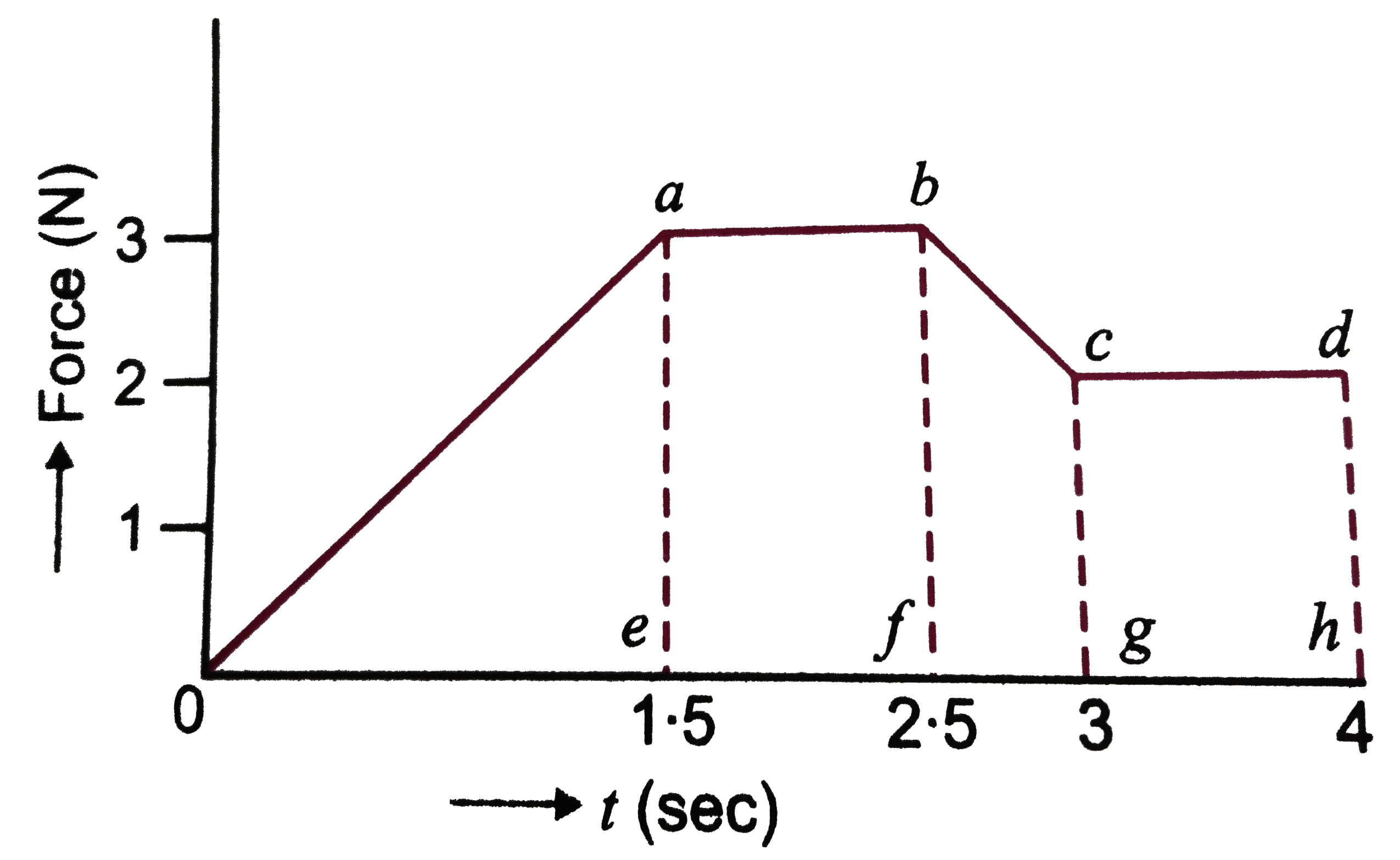 .08:27View Solution
.08:27View SolutionShows position time graph of a particle of mass `100g` Find the impulse at `t = 0` and at `t = 4 s`
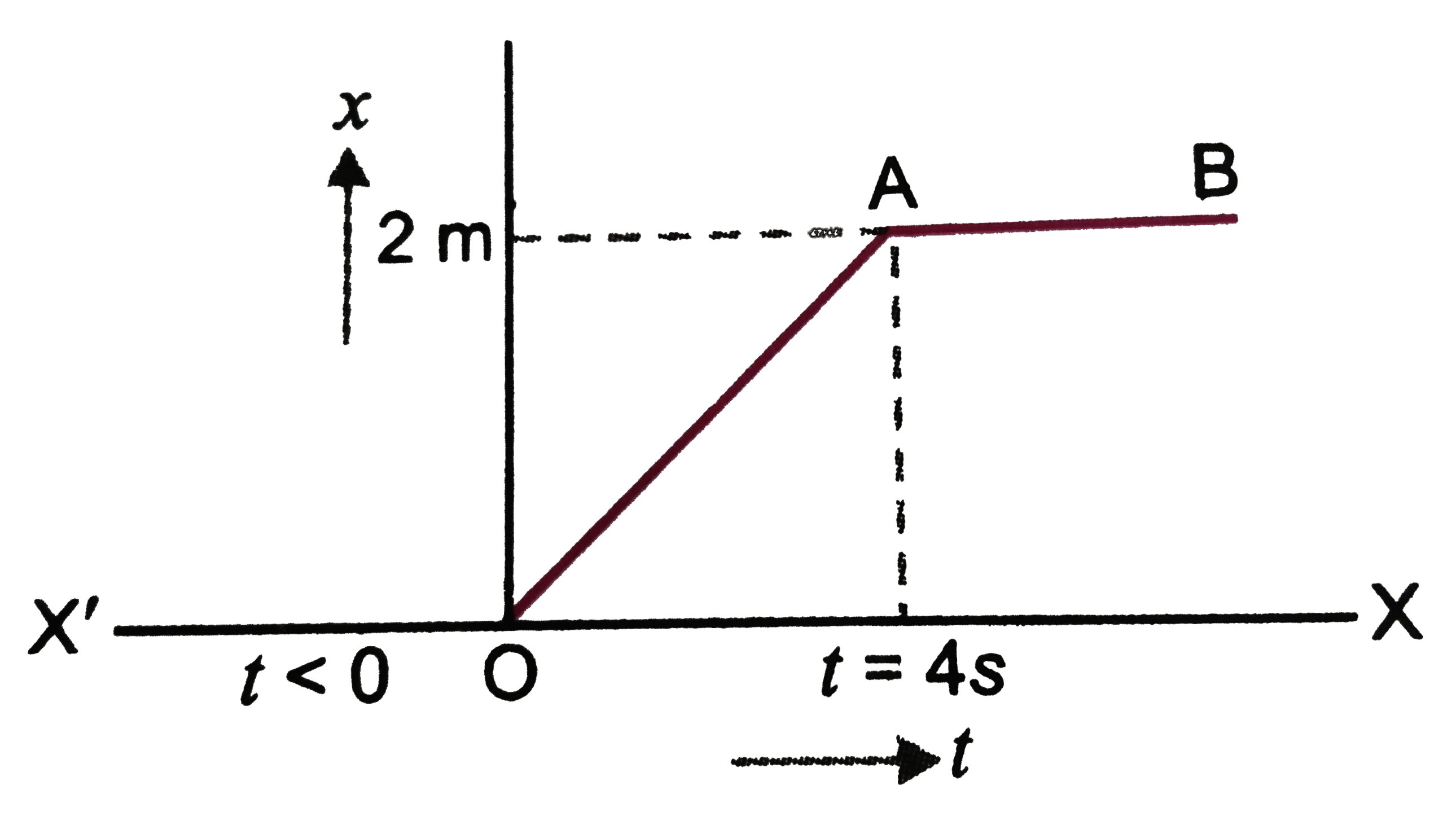 .02:52View Solution
.02:52View SolutionThe strings of a parachute can bear a maximum tension of `72 kg` wt . By what minimum acceleration can a person of 90 kg descend by means of this parachute ?
01:40View SolutionA body of mass `30kg` is hung by a spring balance in a lift. What would be the reading of the balance when the lift is
(i) descending with a constant velocity of `5m//s`
(ii) ascending with a constant velocity of `10m//s` .02:11View SolutionAn elevator starts from rest with a constant downward acceleration and covers `2.5m` in first second If the lift weighs `200kg` what would be the tension in the ropes of the lift ?
03:02View SolutionAn elevator weighs `4000kg` When the upward tension in the supporting cable is `48000 N` what is the upward acceleration? Starting from rest, how far does it rise in `3` seconds ?
02:38View SolutionAn elevator and its load weigh a total of `800kg` Find the tension `T` in the supporting cable when the elevator originally moving downwards at `20m//s` is brought to rest with constant retardation in a distnce of `50m`.
03:19View SolutionA boy holding a spring balance in his hand suspends a weight of `1kg` from it The balance slips from his hands and falls down . What will be the reading of the balance while it is in air. ?
01:29View SolutionA man of mass `85kg` stands on a lift of mass `30kg` When he pulls on the rope he exerts a force of `400N` on the floor of the lift Calculate acceleration of the lift Given `g =10 m//s^(2)` .
06:17View SolutionA body of mass `50kg` is put on a spring weighing machine in a lift What is the reading of the machine when (i) Lift ascends with a unifrom velocity of `10m//s` (ii)descends with an acceleration of `5m//s^(2)` ? Take `of = 10m//s^(2)` .
04:24View SolutionA `40kg` shell is flying at a speed of `72km//h` It explodes into two pieces One piece of mass `15kg` just stops . What is the speed of the other ?
04:03View SolutionA truck of mass `2 xx 10^(4)kg` travelling at `1.5m//s` collindes with another truck of mass `3 xx 10^(4)kg` moving with a velocity of `2.5m//s` in opposite direction If the trucks couple on collision what is their velocity?
03:39View SolutionA gun weighing `9kg` fires a bullet of `30g` with a velocity of `300m//s` What is the recoil velocity of the gun? What is the combined momentum of gun and the bullet before and after firing ?
06:54View SolutionA machine gun has a mass of `20kg` If fires `25g` bullets at the rate of `600` bullets per minute with a speed of `200ms^(-1)` Calculate (i) recoil velocity of the gun (ii) force required to keep the gun in position .
05:50View SolutionA stream of water flowing horizontal with a speed of `15 ms^(-1)` gushes out of tube of cross sectional area `10^(2) m^(2)` and hits at a vertical wall nearby . What is the force exerted by the impact of water, assuming that water rebounds with the same speed.
03:55View SolutionA bullet of mass `7kg` is fired into a block of metal weighing `7kg` The block is free to move Caluculte initial velocity of the bullet if the velocity of the block with the bullet in is `0.7m//s` .
03:21View SolutionA bomb at rest explodes into three fragments of equal massses Two fragments fly off at right angles to each other with velocities of `9m//s` and `12//s` Calculate the speed of the third fragment .
03:27View SolutionA bomb at rest explodes into three parts of the same mass. The linear momenta of the two parts are `-2phati` and `p hati` Calculate the magnitude of momentum of third part .
01:57View SolutionA body of mass `1kg` initially at rest explodes and breaks into threee fragments of masses in the ration breaks into three fragments of masses in the ration `1: 1: 3`. The two pieces of equal masses fly off perpendicular to each other with a speed of `30m//s` each What is the velocity of heavier fragments ? .
05:09View SolutionA balloon with mass `m` is descending down with an acceleration a `(where altg)` . How much mass should be removed from it so that it starts moving up with an acceleration a?
05:16View SolutionIn the first second of its flight a rocket ejects `(1)/(60)` of its mass with a reative velocity `2073ms^(-1)` What is the initial acceleration of the rocket ? .
02:21View SolutionA rocket is going upwards with accelerated motion A man sitting in the rocket feels his weight becomes 5 times If mass of rocket inculding that of the man is `0.1 xx 10^(4)kg` how much force is beigh applied by rocket engine? Take `g = 10m//s^(2)` .
02:01View SolutionFuel is consumed at the rats of `100kg//s` in a rocket The exhaust gases are ejected at a speed of `4.5 xx 10^(4) ms^(-1)` w.r.t the rocket What is the thrust experienced by the rocket Also calculate velocity of the rocket at the instant when its mass is reduced of rocket to be zero .
04:56View SolutionCalculate the ratio `m_(0)//m` for a rocket to attain the escape velocity of `11.2km s^(-1)` after starting from rest, when maximum exhaust velocity of gases is `1.6km//s` .
03:33View SolutionA rocket of initial mass `6000kg` ejects mass at a constant rate of `16kg//s` with constant relative speed of `11m//s` What is the acceleration of the rocket one mnute after blast ?
02:37View SolutionIf the maximum possible exhaust velocity of a rocket be `2km//s` calculate the ratio `m_(0)//m` for it to acquire a veocity of `11.2km//s` after starting from rest .
02:26View SolutionA rocket consumes `24kg` of fuel per second The burnt gases escape the rocket at a speed of `6.4km//s` relative to the rocket Calculate the upthrust recevied by the rocket Also calculate the velocity acquired by the rocket when the mass redues to `1//100th` of its initial mass.
02:51View SolutionA body of weight `200N` is suspended with the help of strings as show in Find the tensions in the strings
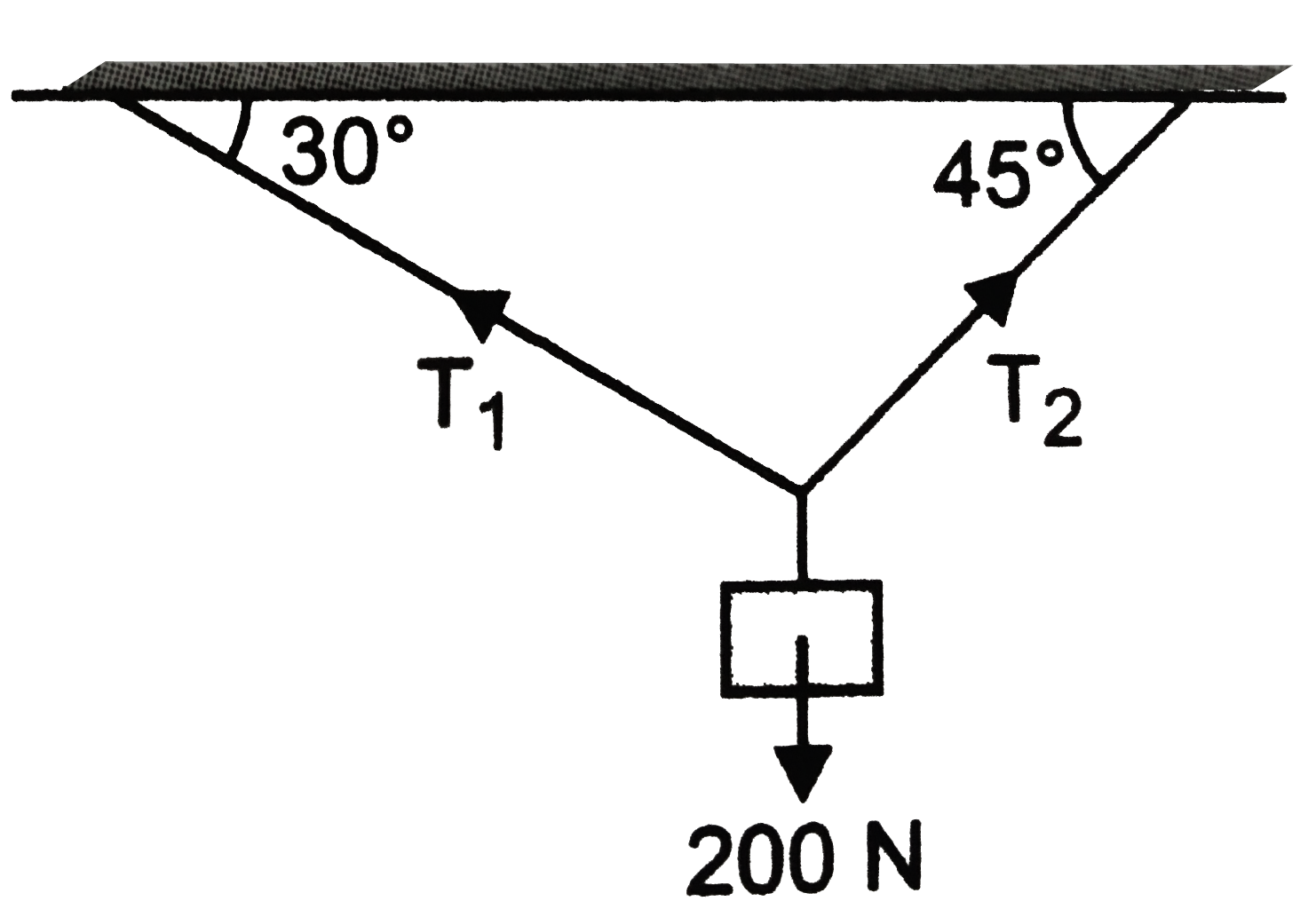 .04:14View Solution
.04:14View SolutionA ball of mass `1kg` hangs in equilibrium from two strings as shown in If `g = 10m//s^(2)` what are the valuse of tension in strings `OA` and `OB`
 .04:03View Solution
.04:03View SolutionTwo bodies of masses `11kg` and `11.5kg` are connected by a long light string passing over a smooth pulley Calculate velocity and height ascended/descended by each body at the end of `4s` .
04:50View SolutionA rope of mass `0.5kg` is pulling a block of mass `10kg` under the action of force of `31.5N` If the block is resting on a smooth horizontal surface calculate the force of reaction exerted by the block on the rope .
03:13View SolutionTwo bodies of masses `4kg` and `3kg` respectively are connected by a light string passing over a smooth frictionless pulley Calculate the acceleration of the masses and tension in the string .
04:08View SolutionTwo bodies whose masses are `m_(1) =50kg` and `m_(2) =150kg` are tied by a light string and are placed on a frictionless horizontal surface When `m_(1)` is pulled by force `F` an acceleration of `5ms^(-2)` is produced in both the bodies Calculate the value of `F` What is the tension in the string `1` ?
02:36View SolutionTwo blocks of mass ` m_(1) and m_(2)` lie on smooth horizontal table in contact with each other as shown in figure

If a force F is applied to the mass `m_(1)` then the contact force between the block will be01:43View SolutionWhen we ignore friction and mass of pulley what would be the accelerations of the two blocks `m_(1)` and `m_(2)`
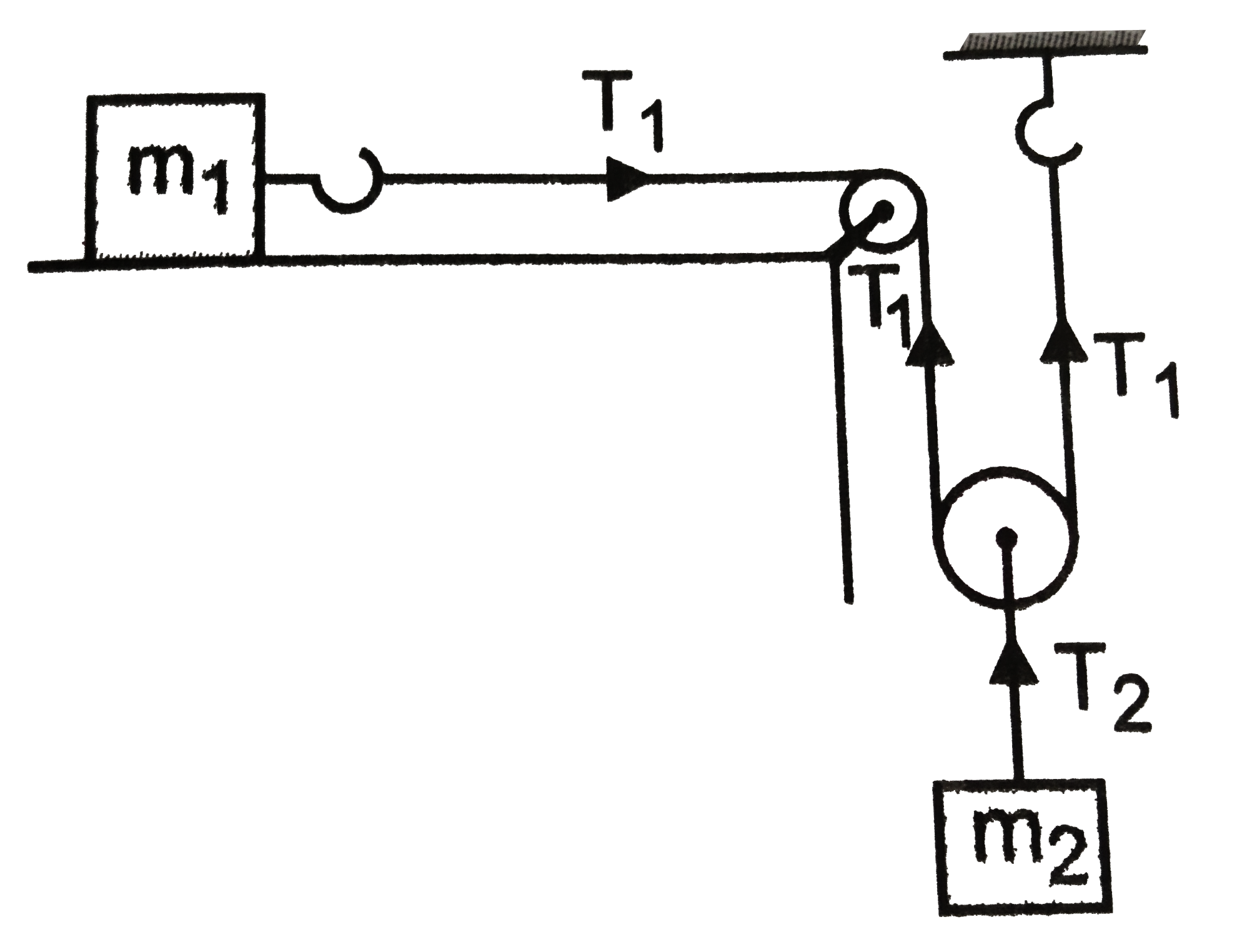 .03:47View Solution
.03:47View SolutionIn the arrangement shown in show that tension in the string between masses `m_(2)` and `m_(3)` is `T = (2 m_(1) m_(3) g)/(m_(1) + m_(2) + m_(3))`
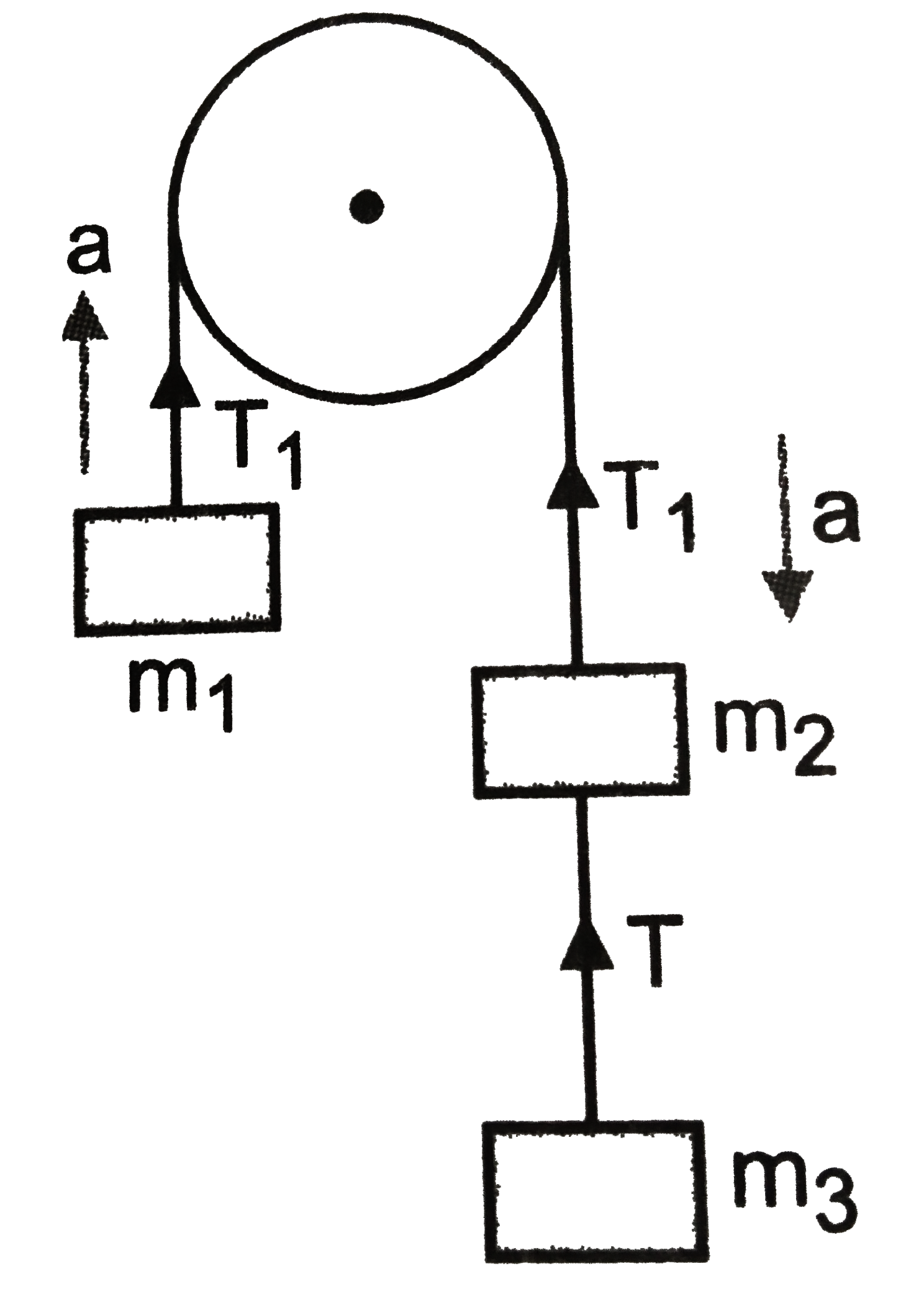 06:07View Solution
06:07View SolutionA car of mass one metric ton travelling at `32m//s`c dashes into the rear of a truck of mass `8000kg` moving in the same direction with a velocity of `4m//s` After the collision the car bounces back wards with a velocity of `8m//s` What is the velocity of the truck after the impact ?
02:49View SolutionThe force on a particle of mass `10g` is `(hati 10+hatj 5)`N If it starts from rest what would be its position at time `t=5s` ?
04:12View SolutionA suitcase is gently dropped on a conveyor belt moving at `3ms^(-1)` If the coefficient of friction between the belt and suitcase is `0.5` how far will the suitcase move on the belt before coming to rest ?
03:19View SolutionAn engine of `100H.P` draws a train of mass `100` metic ton with a velocity of `36km h^(-1)` Find the coefficient of friction.
04:35View SolutionA force ofv `3kg` wt is just sufficient to pull a block of `4kg` over a horizontal surface .What is the angle of friction ?
03:37View SolutionAn automobile is moving on a horizontal road with a speed `upsilon` If the coefficient of friction between the tyres and the road is `mu` show that the shortest distance in which the automobile can be stooped is `upsilon^(2)//2 mu g`.
02:22View SolutionA motor car running at the rate of `7ms^(1)` can be stooped by applying brakes in `10m` Show that total resistance to the motion when brakes are on is one fourth of the weight of the car .
01:55View SolutionA horizontal force of `1.2kg` is applied on a `1.5kg` block, which rests on a horizontal surface If the coefficient of friction is `0.3` find the acceleration produced in the block.
02:40View SolutionA car starts with a velocity of `100m//s` on a half kilometre long bridge The coefficient of friction between the tyres and road is `0.1` Show that one cannot drive throught the bridge in less than `10 s` Take `g = 10m//s^(2)`.
05:29View SolutionA train weighing `1000` quintals is running on a level road with a unifrom speed of `72km//h` If the frictional resistance amounts to 50g wt. per quintal find power in watt, take `g = 9.8ms^(2)`.
02:29View SolutionA body moving on the ground with a velocity of `15m//s` comes to rest after covering a distance of `25m` If acceleration due to gravity is `10m//s^(2)` Calculate the coefficient of friction between the ground and the body .
03:06View SolutionA box of mass `4kg` rests upon an inclined plane This inclination is gradually incresed till the box starts sliding down the plane. At this stage slope of the plane is 1 in 3 Find coefficient of friction between the box and the plane What force applied to the box parallel to the plane will just make the box move up the plane ?
05:47View SolutionWhen a car moving with a speed of `36km//h` reaches an upwards inclined road of angle `30^(@)` its engine is switched off If coefficient of frition involved is `0.1` how much distance will the car move before coming to rest `Given `g = 10m//s^(2)`.
03:14View SolutionAn engine of mass `6.5` metric ton is going up an incline of 5 in 13 at the rate of `9km//h` Calculate the power of the engine if `mu = 1//2` and `g = 9.8m//s^(2)`.
04:20View SolutionA body of mass m is released from the top of a rough inclined plane of length l and height h If f is the force of friction prove that the body will reach the bottom with a velocity `upsilon = sqrt((2)/(m) (m g h - f l))` .
03:03View SolutionA block slides down an incline of `30^(@)` with the horizontal starting from rest it covers `8m` in the first two seconds Find the coefficient of kinetic friction between the two .
06:13View SolutionIn a children park an inclined plane is constructed with an angle of incline `45^0` in the middle part figure. Find the acceleration of a boy sliding on it if the friction coefficient between the cloth of the boy and the incline is 0.6 and g=10 m/`s^2`.
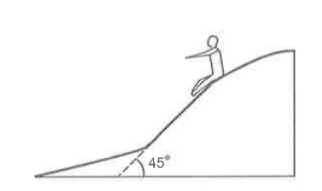 03:48View Solution
03:48View SolutionA block slides down an incline of angle `30^(@)` with an acceleration of `g//4` Find the coefficient of kinetic friction .
02:45View SolutionA force of `98N` is just able to move a body of weight `45kg` on a rough horizontal surface What are the coefficient of friction and angle of friction ? .
02:57View SolutionA block of mass 2kg rests on a rough inclined plane making an angle of `30^@` with the horizontal. The coefficient of static friction between the block and the plane is 0.7. The frictional force on the block is
05:28View SolutionAn engine draws a train up an incline of `1` in `100` at the rate `36km//h` If the resistance due to friction is `5kg` per metric ton calculate the power of the engine given mass of train and engine is `100` metic ton .
04:46View SolutionCalculate the power of an engine which can pull a train of mass `25000` quintal up an incline of 1 in 100 at the rate of `10.8km//h` Resistance due to friction is `2N//"guintal"`.
04:39View SolutionA mass of `100kg` is resting on a rough inclined plane of angle `30^(@)` If the coefficient of friction is `1//sqrt3` find the greatest and the least forces that acting parallel to the plane in both cases just maintain the mass in equilibrium .
03:45View SolutionA truck tows a trailor of mass `1200kg` at a speed of `10m//s` on a level road The tension in the coupling is `1000N`
(i) What is power expended on the trailor ?
(ii) Find tension in the coupling when the truck accends a road having an inclination of `1` in `6` Assume that the frictional resistance of the incline is same as that on the level road .04:26View SolutionAn engine of one metric ton is going up an inclined plane of slope 1 in 2 at the rate of `36km h^(-1)` If the coefficient of friction is `1//sqrt3` calculate the power of the engine in k W .
04:33View SolutionA particle of mass 21 g attached to a string of `70cm` length Keeping the string always taut the ball describes a horizontal circle of radius `15cm` Calculate the angular speed of the ball .
01:25View SolutionA ball of mass `0.1kg` is suspended by a string `30 cm` long Keeping the string always taut the ball describe a horizontal circle of radius `15cm` Calculate the angular speed of the ball .
02:59View SolutionA car of mass `1500kg` is moving with a speed of `12.5ms^(-1)` on a circular path of radius `20m` on a level road What should be the frictional force to avoid slipping of car Calculate the cofficient of friction .
02:38View SolutionWhat is the angular velocity in rad `s^(-1)` of the hour minute and second hand of a clock ?
02:02View SolutionWhat is the greatest speed at which a car having a track width of `1.5m` can turn in a circular path of radius `24.5m` without overturning ? Assume that the center of gravity of the car is `0.49m` above the ground. Take `g = 9.8m//s^(2)` .
03:56View SolutionOne end of a massless sprinf of spring constant 100 N/m and natural length 0.5 m is fixed and the other end is connected to a particle of mass 0.5 kg lying on as frictionless horizontla table. The spring remains horizontal. If the mass is made to rotate at an angular velocityof 2 rad/s, find the elongation of the spring.
04:54View SolutionA body of mass `0.5kg` is wirled in a circle with a velocity of `2ms^(-1)` using `0.5m` length of a string which can withstand a tension of `15N` Neglecting the force of gravity on the body predict whether or not the string will break Give reasons for your answer .
01:52View SolutionThe blades of an aeroplane propeller are `2m` long and rotate at the rate of `300rpm` Calculate (i) the frequency (ii) the period of rotation (iii) the angular velocity (iv) the linear velocity of a point `0.5m` from the tip of the blade .
03:42View SolutionFind the maximum speed at which a car can turn round a curve of `30 m` radius on a level road if coefficient of friction between the tyres and road is `0.4. Take g = 10 m//s^(2)`.
04:35View SolutionA bend in a level road has a radius of 100 m Find the maximum speed which a car turning this bend may have without skidding if coefficient of friction between the tyres and the road is 0 .8 S .
01:50View SolutionAn aeroplane travelling at a speed of `500km h^(-1)` tilts at an angle of `30^(@)` as it makes a safe turn What is the radius of the curve ?
03:51View SolutionA curve in a road froms an arc of radius `800m` If the road is `19.6m` wide and outer edge is `1m` higher than the inner edge calculate the speed for which it is banked.
04:44View SolutionFor traffic moving at `60km//h` if the radius of the curve is `0.1km` what is the correct angle of banking of the road Given `g = 10m//s^(2)` .
04:28View SolutionA cyclist goes round a circular track of `440` metres length in `20` seconds Find the angle that his cycle makes with the verticle.
03:27View SolutionA cyclist speeding at `18 km// h` on a level road takes a sharp circular turn of radius 3 m without reducing the speed . The coefficient of static friction between the tyres and the road is 0.1 Will the cyclist slip while taking the turn ?
02:25View SolutionAn electric bulb suspended from the roof of a railway train by a flexible wire shifts through an angle of `19^(@) 48` when the train goes horizontally round a curved path of `200m` radius Find the speed of the train .
03:51View SolutionA 2000 kg car has to go over a turn whose radius is `750 m` and the abgle of slopw is `5^(@)`. The coefficient of friction between the wheels and the road is 0.5. What should be the maximum speed of the car so that it may go over the turn without slipping ?
01:15View SolutionA motore cyclist goes round a circular race course of diameter `320m` at `144km//h` How far from the verticle must he lean inwards to keep his balance ? Take `g = 10ms^(-2)` .
03:48View SolutionThe radius of curvature of railway track at a place where the train is moving at a speed of `72km h^(-1)` is `625m` The distance between the rails is `1.5m` Find the angle and the elevation of the outer rail so that there may be no side pressure on the rails Take `g = 9.8ms^(-2)` .
03:28View SolutionThe railway bridge over a canal is in the from of an arc of a circle of radius `20m` What is the minimum speed with which a car can cross the bridge without eving contact with the ground at the highest point Take ` g = 9.8ms^(-2)` .
01:48View SolutionA weightless thread can bear tension upto `3.7 kg` wt A stone of mass `500g` is tied to it and revolves in a verticle circle of radius `4m` What will be the maximum angular velocity of the stone if `g = 10 m//s^(2)` .
03:01View Solution
Problems for practice questions and complete solutions for chapter LAWS OF MOTION of PRADEEP PHYSICS (HINGLISH) of Class 11
All Exercises from PRADEEP Class 11 PHYSICS LAWS OF MOTION
- Additional Examples / Exercises
- Advanced problems for competitions
- Assertion- Reason Type Questions
- conceptual problmes
- Curiosity Question
- EXERCISES
- Fill in the blanks
- Higher order thinking skills
- Integer Type Questions
- JEE (Main and Advanced)/ Medical Entrance Special
- Long Answer Questions
- Multiple Choice Questions
- Problems for practice
- sample problems
- Short Answer Questions
- Short Answer Questions
- solved examples
- Value Based Questions with Answers
- Very short answer questions
